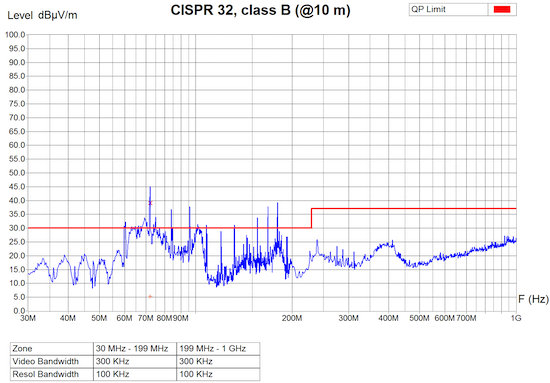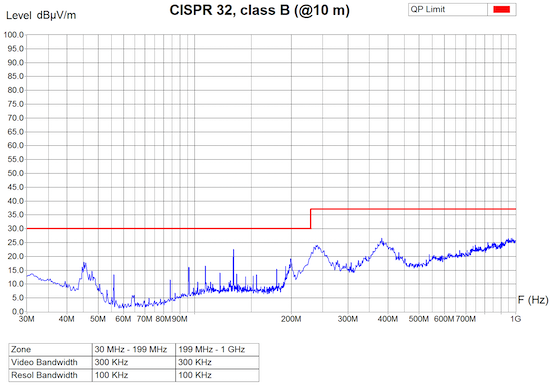![]() Six years ago, we wrote a post on the influence of the electric resistance of USB cables on the proper working of peripheral devices. Today, we are going to talk about a little-known related problem, which drove us to change our USB cable provider: the shielding of USB cables.
Six years ago, we wrote a post on the influence of the electric resistance of USB cables on the proper working of peripheral devices. Today, we are going to talk about a little-known related problem, which drove us to change our USB cable provider: the shielding of USB cables.
Why a shield?
According to USB 2.0 standard, a USB cable must be made minimally of 5 conductors: the two power supply wires, the differential pair for communication, and a fifth conductor for shielding made of a stranded copper bread, which must surround all the others on the whole length of the cable and be connected to the plug shells at both ends. Even the slower version, said full-speed at 12Mb/s, also called USB 1.1, requires a shielded cable (see USB 2.0 specifications, paragraph 6.1).
However, if you perform tests with a shielded cable and an unshielded cable, there is a good chance that you won't see any apparent difference. So what is the purpose of shielding? Here is a short story as an answer.
A little while ago, we went to the accredited test laboratory to make electromagnetic compatibility measurements for a module. As we were leaving the office, we took the USB cables at hand. But during the module emission measurements, we had a very bad surprise:

Emissions of a Yocto-3D-V2 with a poorly shielded USB cable
If you are not familiar with that kind of EMI graph, just know that any measure above the red line is a big no no.
We lost a great amount of time looking for the source of the problem, until we noticed that the USB cable we were using was not quite the same as usual. By replacing the cable with a properly shielded one, everything went back to normal:

Emissions of a Yocto-3D-V2 with a properly shielded cable
Apart from the mandatory side of legal limits of emissions, which has its own importance, these measures show the effectiveness that shielding has to limit the effects of electromagnetic disturbances. Indeed, shielding is also very useful to protect devices against external disturbances which could be induced in the cables, for example during transient burst on mains close to a USB cable. Such failure in implementing the required immunity standard are at the origin of the poor reputation of USB in the industrial environment, compared to the old RS232 connections for example, which are often considered more robust due to the higher voltage levels used for signalling.
USB cable test bench
As we were tricked by a bad cable, we decided to perform some tests on cables commercially available as "USB 2.0"... According to USB 2.0 specifications (section 6.6.3), the resistance between the two shield shells, through the shielding, should not go over 0.6Ω. We therefore bought different cables from all categories, and we implemented a cable tester, based on the principle described in a previous post.
As we wanted to measure the resistance of several conductors, we used a Yocto-MaxiBridge, which has four measuring inputs. Needing to measure resistances below 1Ω, we had to guaranty very good contacts at all the measuring points. We therefore manufactured a small circuit which we could easily solder directly on the Yocto-MaxiBridge, which directly contains the USB connectors adapted to the cables to be tested and the precision resistances for the ratiometric measure.

Our precision USB cable tester
We only had to connect each cable to be tested, and the result of the measure appeared instantaneously on the interface:

Cable tester interface
The results
The results are ... enlightening. Most entry-level "USB 2.0" cables that are commercially available, although sometimes sold for more than $10, are not shielded, or are not well shielded, which is about the same. Here is what we can see if we open with a cutter the plastic overmolding around USB connectors:

In some cheap cables, there is no shield at all. This type of cable is absolutely not compliant and should not be sold under the USB 2.0 name.

Often, the cable itself is shielded, but the connectors are not. Sometimes, to pretend, a small wire from the cable shield is soldered to the ground contact, so that a test with a "beeper" provides the impression of a proper shielding. It was such a cable that misled us during our emission tests.
Shield resistance: 3.3Ω, non-compliant.

Some manufacturers buy good equipment, but do not have the right machines to assemble it. You find yourself with cables such as this one where a good connector with a shielded shell is crimped on a plastic molding instead of being crimped on the cable shield. As a result, the conductivity of the shielding is again only ensured by a small wire.
Shield resistance: 3.6Ω, non-compliant.
Without measuring tools and without references, the only relatively safe way to get a good USB cable in a supermarket is to buy the "luxury" version with gold connectors, often sold for more than $30. All the cables that we tested from this range were properly shielded. But 30$, it's a bit expensive for a USB cable...
Fortunately, we unearthed a brand that manufactures its USB cables properly, and which sells them at a reasonable price: Delock. It's therefore these cables that we resell since last Spring.
Unfortunately, Delock doesn't commercialize microB-micro-B-OTG cables, such as you need to connect our modules to an Android phone or to our YoctoHubs. In fact, no microB-microB-OTG cable that we found off the shelf was properly shielded. So we had to find a cable manufacturer which agreed to make some for us according to the specifications. They are these ones that we offer on our shop.
Conclusion
If you want to reproduce this cable tester at home, you can contact us to obtain PCB manufacturing instructions. When you order your Yocto-MaxiBridge, don't forget to tell us that you want it without terminal, to be able to directly solder the circuit containing the connectors.
And if you want to build a system based on USB modules, and if you must have your system certified, remember this post and use shielded USB cables!


